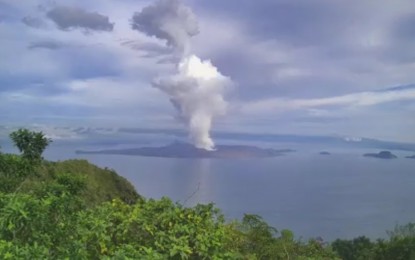
(Screengrab from PAGASA's Facebook page on Friday, Oct. 15, 2021)
MANILA – Ten days after the highest recorded volcanic sulfur dioxide (S02) emission in Taal Volcano was recorded, another "anomalously high" S02 emission has been observed, the Philippine Institute of Volcanology and Seismology (Phivolcs) reported on Friday night.
A total of 23,576 tonnes of volcanic S02 gas emission from the Taal main crater was recorded on Friday.
Phivolcs on Oct. 5 reported that 25,456 tonnes/day S02 emission was observed in the Taal volcano.
"SO2 flux this month has averaged 9,872 tonnes/day as the trend in average flux continues to increase since March 2021," an advisory read.
Degassing at the Taal main crater has been noticeably voluminous and generated steam-laden plumes as high as 3,000 meters above the Taal Volcano Island (TVI).
Thick vog observed over the Taal Caldera region could drift to the general north to west based on air parcel trajectory forecasts from the weather bureau.
Phivolcs also noted that volcanic earthquake activity at Taal resumed on October 11 after a period of lull that began on September 27.
A total of 145 tremors consisting mostly of weak low-frequency earthquakes and volcanic tremor that are associated with magma and magmatic gas flow have been recorded since seismic activity resumed until 4 p.m. Friday.
Alert Level 2 or decreased unrest still prevails over Taal Volcano. Current S02 parameters indicate high levels of magmatic degassing from the main crater, which could result in explosive activity.
Phivolcs reiterated that at Level 2, sudden steam or gas-driven explosions, volcanic earthquakes, minor ashfall, and lethal accumulations or expulsions of volcanic gas can occur and threaten areas within and around TVI.
Entry into TVI, especially the vicinities of the main crater and the Daang Kastila fissure, as well as activities on Taal Lake, must be strictly prohibited, Phivolcs advised. (PNA)
